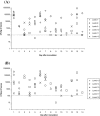Intermittent Escherichia coli O157:H7 colonisation at the terminal rectum mucosa of conventionally-reared lambs
- PMID: 18959839
- PMCID: PMC2695016
- DOI: 10.1051/vetres:2008047
Intermittent Escherichia coli O157:H7 colonisation at the terminal rectum mucosa of conventionally-reared lambs
Abstract
In cattle, the lymphoid rich regions of the rectal-anal mucosa at the terminal rectum are the preferred site for Escherichia coli O157:H7 colonisation. All cattle infected by rectal swab administration demonstrate long-term E. coli O157:H7 colonisation, whereas orally challenged cattle do not demonstrate long-term E. coli O157:H7 colonisation in all animals. Oral, but not rectal challenge of sheep with E. coli O157:H7 has been reported, but an exact site for colonisation in sheep is unknown. To determine if E. coli O157:H7 can effectively colonise the ovine terminal rectum, in vitro organ culture (IVOC) was initiated. Albeit sparsely, large, densely packed E. coli O157:H7 micro-colonies were observed on the mucosa of ovine and control bovine terminal rectum explants. After necropsy of orally inoculated lambs, bacterial enumeration of the proximal and distal gastrointestinal tract did suggest a preference for E. coli O157:H7 colonisation at the ovine terminal rectum, albeit for both lymphoid rich and non-lymphoid sites. As reported for cattle, rectal inoculation studies were then conducted to determine if all lambs would demonstrate persistent colonisation at the terminal rectum. After necropsy of E. coli O157:H7 rectally inoculated lambs, most animals were not colonised at gastrointestinal sites proximal to the rectum, however, large densely packed micro-colonies of E. coli O157:H7 were observed on the ovine terminal rectum mucosa. Nevertheless, at the end point of the study (day 14), only one lamb had E. coli O157:H7 micro-colonies associated with the terminal rectum mucosa. A comparison of E. coli O157:H7 shedding yielded a similar pattern of persistence between rectally and orally inoculated lambs. The inability of E. coli O157:H7 to effectively colonise the terminal rectum mucosa of all rectally inoculated sheep in the long term, suggests that E. coli O157:H7 may colonise this site, but less effectively than reported previously for cattle.
Figures





References
-
- Best A., La Ragione R.M., Clifford D., Cooley W.A., Sayers A.R., Woodward M.J.. A comparison of Shiga-toxin negative Escherichia coli O157 aflagellate and intimin deficient mutants in porcine in vitro and in vivo models of infection. Vet. Microbiol. 2006;113:63–72. - PubMed
-
- Borczyk A.A., Karmali M.A., Lior H., Duncan L.M.. Bovine reservoir for verotoxin-producing Escherichia coli O157:H7. Lancet. 1987;1:98. - PubMed
-
- Chapman P.A., Cerdan-Maló A.T., Ellin M., Ashton R.. Escherichia, coli O157 in cattle and sheep at slaughter, on beef and lamb carcasses and in raw beef and lamb products in South Yorkshire, UK. Int. J. Food Microbiol. 2001;64:139–150. - PubMed
Publication types
MeSH terms
LinkOut - more resources
Full Text Sources
Medical
Research Materials
